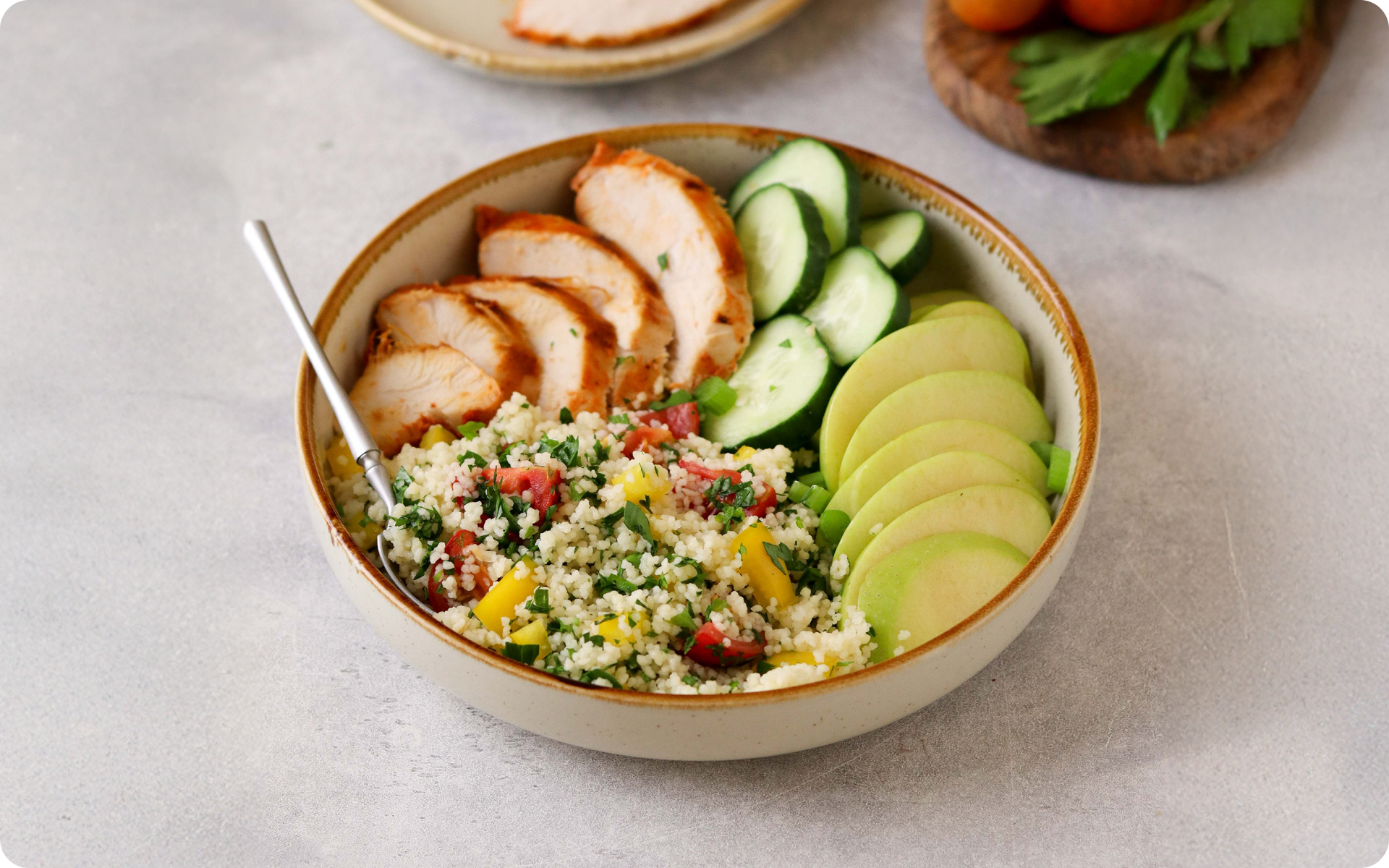It’s likely that you’ve heard that eating a well-balanced diet is essential for supporting your overall health, energy levels, and well-being. However, with all the conflicting information online, knowing where to start can be a challenge. Fortunately, creating a healthy nutrition plan doesn’t need to be stressful.
A well-structured nutrition plan ensures you strike the right balance of nutrients to support your health and fitness goals, whether that’s weight loss, muscle gain, better digestion, or overall health. Unlike restrictive diets, research has suggested that personalized nutrition plans focused on sustainability can help you develop a long-term approach to healthy eating (1).
This guide will walk you through how to make a nutrition plan, including the steps for structuring meals, determining calorie intake, and adjusting your plan to suit your lifestyle.
Why Should You Make a Nutrition Plan for Yourself?
A solid nutrition plan can help you stay on track with your eating habits. Without a plan, it’s easy to fall into poor eating patterns, such as skipping meals, overeating, or relying on ultra-processed foods.
“Creating a nutrition plan can help you feel more in control of your health and eating patterns and also give you valuable information about how certain foods affect your energy, hunger, or digestion,” says Kelsey Kunik, RDN, a registered dietitian at Graciously Nourished. “A nutrition plan can be as detailed or relaxed as you’d like and can be tailored to fit your individual goals, preferences, and needs.”
A structured approach can help you establish healthy eating habits that support your long-term goals, whether that’s sustained energy, improved digestion, or weight management. Melissa Mitri, RD, nutrition writer and owner of Melissa Mitri Nutrition, tells us, “Having a solid plan in place also helps set you up for success and doesn’t leave your food decisions to chance.”
In addition, a nutrition plan reduces decision fatigue, which makes it easier to stay consistent with healthy choices. Many people struggle with meal planning as they feel overwhelmed by too many options. When you take the time to plan, you eliminate last-minute stress, reduce grocery costs and waste, and ensure your diet is balanced and nutrient-dense.
How Do I Create a Nutrition Plan for Myself?
Before you start planning, it’s important to get crystal clear on what your goals are and why you want a nutrition plan. Kunik explains, “If your focus is to gain muscle or lose weight, your plan may emphasize protein. If you’re hoping to improve digestion or heart health, you may be more focused on high-fiber foods.”
To create a well-balanced nutrition plan, follow these steps:
- Determine Your Daily Caloric Needs: Use a calorie calculator that considers your age, weight, height, and activity level to estimate your maintenance calories. Mitri recommends using a trusted calorie calculator, such as the one provided by Mayo Clinic, for more accurate results.
- Select a Macronutrient Ratio: The acceptable macronutrient distribution ranges are 45-65% of calories from carbohydrates, 10-35% from protein, and 20-35% from fats, but your specific targets may vary depending on your goals.
- Choose Nutrient-Dense Foods: Prioritize whole, minimally processed foods that provide essential vitamins and minerals, fiber, and protein.
- Plan Your Meals and Snacks: Spread your calorie intake throughout the day to help maintain steady energy levels and support digestion.
- Make Adjustments Based on Your Lifestyle: If you have a busy schedule, try meal prepping or making quick, simple recipes that suit your goals.
Mitri suggests breaking down your meal structure. She says, “Start by outlining your day into meals – breakfast, lunch, dinner, and snacks. Then, fill in each meal with foods you enjoy that also align with your health goals.”
If you wish to free yourself from all the extra pounds that have been weighing you down for way too long, start using the BetterMe: Health Coaching app and overhaul your entire life!
Many people (myself included) make the mistake of overcomplicating meal planning, which often leads to frustration and inconsistency. In the past I’d try to spend an entire Sunday afternoon meticulously chopping, prepping, and storing my meals, only to feel like I wasted half the day. So it was no surprise then that I would never keep up with this habit for long. Now, I focus on prepping simple, repeatable meals that I love and don’t require hours in the kitchen.
If you work long hours or travel frequently, meal prepping can help make sure you always have healthy options available. You can also use meal delivery services or batch cook on weekends to maintain a consistent eating routine.
The more realistic and adaptable your nutrition plan is, the more likely you are to stick with it long-term. In addition, meal planning has been found to be associated with healthier weight management and improved diet quality (2).
How Do I Know If My Diet Plan Is Right for Me?
A surefire way to know if your diet plan is working is by listening to your body’s cues and being aware of how you feel. Feeling exhausted, constantly hungry, or struggling with cravings could be a sign that your nutrition plan needs adjusting.
“You’ll know your diet plan is right for you if it keeps you satisfied and provides energy without being overly restrictive,” Mitri says. “Pay attention to how you feel while on the plan, and be open to trial and error while you figure out what works for you.”
If you find yourself feeling hungry shortly after meals, you may need to increase your intake of fiber, protein, or healthy fats to promote satiety (3). If you’re feeling sluggish, increasing your carbohydrate intake or timing your meals better can help boost your energy levels (4).
Read more: Greek Yogurt Benefits For Weight Loss: Flavor-Packed, Creamy, And Totally Guilt-Free!
How Do I Calculate My Calorie Intake?
Understanding your body’s caloric needs is non-negotiable for achieving your health goals. “There are many online calorie calculators that can help you determine an estimate of how many calories you need each day,” Kunik says. “The most reliable calculators will consider your weight, height, age, gender, and activity levels.”
According to the National Academy of Sports Medicine, your total daily energy expenditure (TDEE) is determined using a multiplier that is based on your activity level (5):
- Sedentary (little to no exercise): *BMR × 1.2
- Light activity (1-3 days per week): BMR × 1.375
- Moderate activity (3-5 days per week): BMR × 1.55
- Heavy activity (6-7 days per week): BMR × 1.725
*BMR is your basal metabolic rate, which is the number of calories your body burns when at rest to maintain basic functions such as breathing, circulation, and cell production (6).
If your goal is weight loss, you should aim to be in a 300 to 500-calorie deficit each day (7). This means aiming to eat 300-500 fewer calories than your TDEE. To gain muscle, increase your calories by 300 to 500 per day above your TDEE while making sure to consume enough protein (8).
However, not all calories are equal. Two people with the same calorie intake but different macronutrient consumption can experience significantly different results. For example, a diet that is high in refined carbohydrates and added sugars may lead to energy crashes and increased hunger, while a diet that is rich in protein, complex carbohydrates with fiber, and healthy fats supports stable energy and muscle maintenance (9, 10).
Another important factor in calorie calculation is adjusting for metabolic changes. If you’ve been in a caloric deficit for a long time, your metabolism may adapt by burning fewer calories. This is why some experts recommend incorporating periodic refeeds or slight increases in intake to prevent metabolic slowdowns (11). This is also why it’s important not to go too extreme with your calorie deficit or try to lose weight too quickly. Fortunately, monitoring your TDEE and adjusting as needed can help ensure your nutrition plan keeps working for you in the long term.
The BetterMe: Health Coaching app will provide you with a host of fat-frying fitness routines that’ll scare the extra pounds away and turn your body into a masterpiece! Get your life moving in the right direction with BetterMe!
What Foods to Include in a Balanced Nutrition Plan
A nutrient-dense nutrition plan should include a mix of lean protein, complex carbohydrates, and healthy fats, together with fiber and essential vitamins and minerals. These foods can help you plan your weekly meals:
- Protein Sources: Legumes, tofu, Greek yogurt, lean meats, fish, eggs
- Carbohydrates: Whole grains such as oats, brown rice, quinoa, and whole-wheat products, starchy vegetables such as potatoes, sweet potatoes, other root vegetables, and winter squash
- Healthy Fats: Avocados, nuts, seeds, olive oil and other plant-derived oils, fatty fish
- Fiber-Rich Foods: Leafy greens and other vegetables, legumes, berries and other fruits, whole grains
“A balanced nutrition plan should include a mix of protein, fiber-rich carbohydrates, and healthy fats to support energy, digestion, and overall health,” Mitri says.
Many people believe that eating healthy requires them to give up their favorite foods, but a well-balanced plan should focus on inclusion rather than exclusion. Instead of labeling foods as good or bad, aim for an 80/20 approach – 80% whole or minimally processed, nutrient-dense foods and 20% flexibility for foods you enjoy. This approach can help reduce feelings of restriction and deprivation, which makes it easier to stick to your plan in the long term (12).
Read more: Clean Eating Challenge: A Simple Guide To Kickstart Your Journey
How to Adjust a Nutrition Plan for Your Lifestyle
The best nutrition plan is one that you can stick to in the long term and allows for flexibility. If you have a demanding job, meal prepping or choosing quick, easy-to-prepare meals can help you stay consistent. If you follow a plant-based diet, make sure you get enough protein and essential nutrients such as iron and B12 (13).
“No matter how good a plan looks on paper, it’s useless if you can’t adapt it to work for your life,” says Kunik.
Adjusting your nutrition plan along the way is essential as your goals evolve. For example, if you transition from a sedentary lifestyle to strength training, your body will require more protein and total calories (14). Similarly, if you experience digestive discomfort or bloating, you should gradually adjust your fiber intake. Timing your meals can also help (15).
As with any other healthy habit, making small dietary changes over time rather than drastic life overhauls will help ensure your nutrition plan remains flexible and you can be consistent with it in the long term.
Most adults require 0.8 to 1.2 grams of protein per kilogram of body weight daily (16). Athletes or those who are building muscle may need approximately 1.6 to 2.2 grams per kilogram of their body weight (17). This refers to a macronutrient breakdown of your daily calories that should come from 40% carbohydrates, 30% protein, and 30% fats, which is often used for weight loss (18). It’s slightly under the acceptable range for carbohydrates and may not be appropriate for those who are highly active or require a lot of energy. Yes, spreading your protein intake throughout the day can help support muscle repair, increase satiety, and boost metabolism (19). Yes, 20 to 35 percent of your total daily calories should come from healthy fats for optimal hormone regulation and brain function (20).Frequently Asked Questions
How much protein do I need per day?
What are the 40-30-30 macros?
Do I need protein with every meal?
Is 20% fat macro good?
The Bottom Line
A healthy, well-balanced nutrition plan can help you stay consistent, boost your energy levels, and ensure you reach your health and fitness goals. Creating a sustainable eating plan you can stick to in the long term requires you to be clear about your goals, understand your calorie needs, and eat nutrient-dense foods. Mitri says, “The key to long-term success is creating a plan that feels both achievable and enjoyable. Small, consistent changes over time lead to sustainable results.”
DISCLAIMER:
This article is intended for general informational purposes only and does not serve to address individual circumstances. It is not a substitute for professional advice or help and should not be relied on for making any kind of decision-making. Any action taken as a direct or indirect result of the information in this article is entirely at your own risk and is your sole responsibility.
BetterMe, its content staff, and its medical advisors accept no responsibility for inaccuracies, errors, misstatements, inconsistencies, or omissions and specifically disclaim any liability, loss or risk, personal, professional or otherwise, which may be incurred as a consequence, directly or indirectly, of the use and/or application of any content.
You should always seek the advice of your physician or other qualified health provider with any questions you may have regarding a medical condition or your specific situation. Never disregard professional medical advice or delay seeking it because of BetterMe content. If you suspect or think you may have a medical emergency, call your doctor.
SOURCES:
- Effect of Personalized Nutrition on Dietary, Physical Activity, and Health Outcomes: A Systematic Review of Randomized Trials (2022, nih.gov)
- Meal planning is associated with food variety, diet quality and body weight status in a large sample of French adults (2017, nih.gov)
- Snack Food, Satiety, and Weight (2016, sciencedirect.com)
- Physiology, Carbohydrates (2023, nih.gov)
- Calorie Calculator (2025, nasm.org)
- What determines the basal rate of metabolism? (2019, journals.biologists.com)
- Optimal Diet Strategies for Weight Loss and Weight Loss Maintenance (2020, nih.gov)
- Effects of Different Dietary Energy Intake Following Resistance Training on Muscle Mass and Body Fat in Bodybuilders: A Pilot Study (2019, nih.gov)
- A High-Sugar Diet Consumption, Metabolism and Health Impacts with a Focus on the Development of Substance Use Disorder: A Narrative Review (2022, nih.gov)
- Nutrition: Macronutrient Intake, Imbalances, and Interventions (2023, nih.gov)
- Metabolic Consequences of Weight Reduction (2023, nih.gov)
- What is the 80/20 Diet Rule? (2024, virtua.org)
- The importance of vitamin B12 for individuals choosing plant-based diets (2022, nih.gov)
- Dietary Protein and Muscle Mass: Translating Science to Application and Health Benefit (2019, nih.gov)
- Therapeutic Benefits and Dietary Restrictions of Fiber Intake: A State of the Art Review (2022, nih.gov)
- Protein for Life: Review of Optimal Protein Intake, Sustainable Dietary Sources and the Effect on Appetite in Ageing Adults (2018, nih.gov)
- Recent Perspectives Regarding the Role of Dietary Protein for the Promotion of Muscle Hypertrophy with Resistance Exercise Training (2018, nih.gov)
- Micronutrient quality of weight-loss diets that focus on macronutrients: results from the A TO Z study (2010, nih.gov)
- Dietary Protein Distribution Positively Influences 24-h Muscle Protein Synthesis in Healthy Adults (2014, nih.gov)
- Weighing in on Dietary Fats: Some Fats Are Healthier Than Others (2011, nih.gov)











